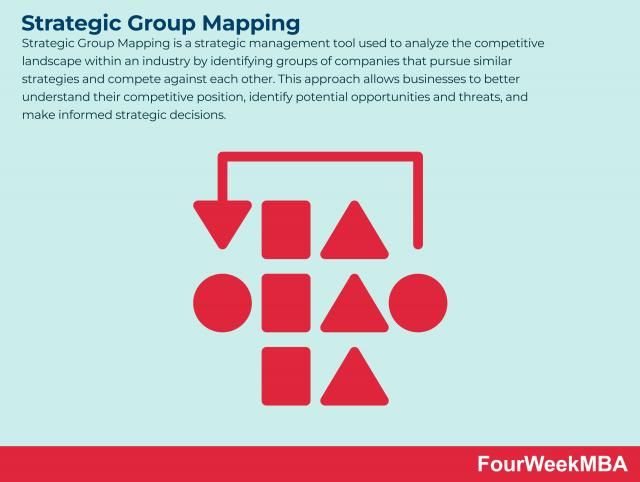Strategic Group Mapping is a Strategic management tool used to analyze the competitive landscape within an industry by identifying groups of companies that pursue similar strategies and compete against each other. This approach allows businesses to better understand their competitive position, identify potential opportunities and threats, and make informed strategic decisions.
Related Articles
Components of Strategic Group Mapping
1. Industry Analysis
Strategic Group Mapping begins with a comprehensive analysis of the industry landscape, including market trends, competitive dynamics, and key success factors. This analysis helps identify the various factors that influence competition within the industry and provides context for strategic group formation.
2. Identification of Strategic Groups
Once the industry landscape is understood, strategic groups are identified based on similarities in strategic choices, competitive positioning, and market performance. Strategic groups typically consist of companies that offer similar products or services, target similar customer segments, and compete in similar geographic regions.
3. Key Dimensions
Strategic Group Mapping involves identifying key dimensions along which companies within the industry vary in terms of their strategic choices and competitive positioning. These dimensions may include product quality, price range, distribution channels, geographic scope, technological innovation, and customer service.
4. Mapping
Using the identified key dimensions, companies are plotted on a strategic group map, typically in a two-dimensional space. This mapping allows for visual representation of the competitive landscape, with each axis representing a different key dimension. Companies that are close to each other on the map are considered to be part of the same strategic group.
Application of Strategic Group Mapping
1. Competitive Analysis
Strategic Group Mapping provides valuable insights into the competitive dynamics within an industry by identifying direct and indirect competitors. By analyzing the positioning and performance of strategic groups, businesses can assess their competitive strengths and weaknesses and identify areas for strategic differentiation.
2. Strategic Positioning
Strategic Group Mapping helps businesses identify their strategic position relative to other players in the industry. By understanding which strategic group(s) they belong to and how they compare to competitors, businesses can develop strategies to leverage their strengths, mitigate weaknesses, and enhance their competitive advantage.
3. Market Segmentation
Strategic Group Mapping facilitates market segmentation by identifying distinct customer segments served by different strategic groups. Businesses can tailor their marketing strategies, product offerings, and distribution channels to better meet the needs and preferences of specific market segments.
Significance of Strategic Group Mapping
1. Strategic Planning
Strategic Group Mapping serves as a valuable tool for strategic planning by providing a comprehensive understanding of the competitive landscape and industry dynamics. Businesses can use this information to formulate and implement strategies that capitalize on market opportunities and address competitive threats.
2. Competitive Intelligence
Strategic Group Mapping enables businesses to gather competitive intelligence by analyzing the strategies and performance of rival firms. By monitoring changes in strategic group positioning and performance over time, businesses can anticipate competitive moves, identify emerging trends, and adapt their strategies accordingly.
3. Decision-Making
Strategic Group Mapping supports informed decision-making by providing executives and managers with actionable insights into the competitive environment. Businesses can use this information to make strategic choices regarding market entry, product development, pricing strategies, and resource allocation.
Implementation and Considerations
1. Data Collection and Analysis
Effective implementation of Strategic Group Mapping requires accurate and up-to-date data on industry trends, competitor strategies, and market performance. Businesses should invest in robust data collection and analysis capabilities to ensure the reliability and validity of strategic group mapping results.
2. Continuous Monitoring
The competitive landscape is dynamic, requiring businesses to continuously monitor changes in strategic group positioning and performance. Regular updates to strategic group maps allow businesses to stay informed about shifting market dynamics and make timely adjustments to their strategies.
3. Flexibility and Adaptability
Businesses must remain flexible and adaptable in their approach to strategic group mapping to accommodate changes in the competitive environment. Strategies that were effective in the past may need to be revised in response to evolving market conditions, technological advancements, or changes in customer preferences.
Conclusion
Strategic Group Mapping is a powerful tool that enables businesses to gain insights into the competitive dynamics within their industry and make informed strategic decisions. By identifying strategic groups, analyzing competitive positioning, and monitoring changes in the competitive landscape, businesses can develop strategies that enhance their competitive advantage, drive growth, and achieve long-term success. As businesses navigate increasingly complex and competitive markets, Strategic Group Mapping remains an indispensable tool for strategic management and decision-making. Through its systematic approach to analyzing industry dynamics, Strategic Group Mapping empowers businesses to thrive in dynamic and challenging environments.
Organizational Structure Case Studies
OpenAI Organizational Structure
Airbnb Organizational Structure
Amazon Organizational Structure
Apple Organizational Structure
Coca-Cola Organizational Structure
Costco Organizational Structure
Dell Organizational Structure
eBay Organizational Structure
Facebook Organizational Structure
Goldman Sachs’ Organizational Structure
Google Organizational Structure
IBM Organizational Structure
McDonald’s Organizational Structure
McKinsey Organizational Structure
Microsoft Organizational Structure
Nestlé Organizational Structure

